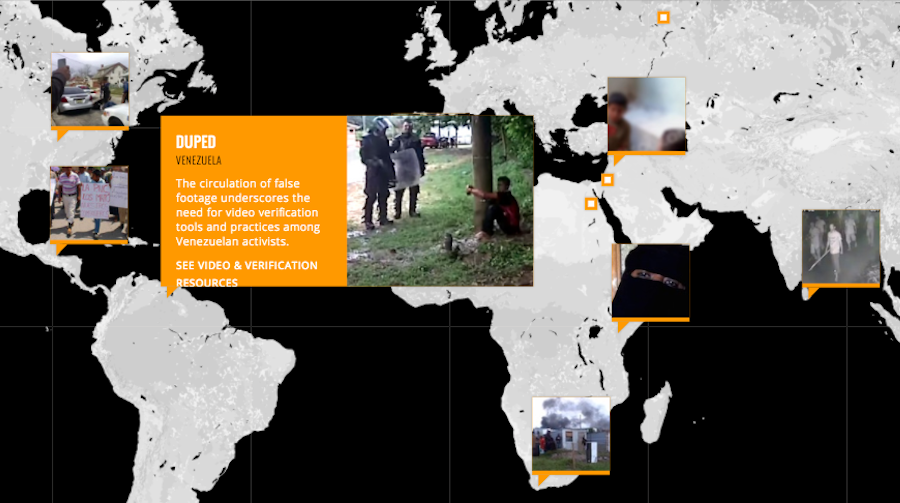
Karen Stevenson is a technologist and journalist who joined WITNESS in April 2016 after winning a fellowship at the human rights organization to focus on the role of eyewitness video in capturing the abuse of people who are trans or gender nonconforming. The project launched six months later, in October, and she became the full-time program manager at the WITNESS Media Lab, sharing technologies, practices and methodologies to “unleash the power” of eyewitness video as a tool for advocacy in human rights.
She described her day-to-day work and some of the challenges facing everyone working with eyewitness video today.
What is the first thing you do at the start of your work day?
The first thing I do is check email, and then I go to Twitter and Facebook and go down the rabbit hole from there. I use Twitter primarily as a kind of clippings service. I follow news organizations and other human rights organizations and thought leaders and I have 21 lists, each according to the area of interest. My Facebook was initially sending pictures of puppies around but now it’s following people and organizations that get me outside of my echo chamber so I can understand what’s on the mind of folks that I might not be talking to on a regular basis.
What are your top three tools for work?
I’m constantly exploring new technologies but Google Docs is the go-to for how we do things at the organisation here because we’re collaborating with people all over the world. And personal productivity tools are the big ones for me. So the things I’m in all the time are Slack, Google Docs and also, because as a technologist I design UX for software, so photoshop is always on there.
What has been the most challenging project you’ve worked on?
There was a project I brought to WITNESS as part of my fellowship called Capturing Hate, which analyzed eyewitness video of violent acts against transgender and gender nonconforming people that were captured, shared and engaged with as entertainment. There’s no data around the lives of trans and gender nonconforming people, and that was the impetus. The source of most data around populations, particularly marginalized populations in the US, comes from federal surveys. And right now, those surveys don’t include sexual orientation or gender identity and without data, there’s very little funding or policy making, if any.
So the goal was to see if eyewitness video could be a source for data for those communities, to expose the truth, to tell stories about the challenges and abuses of trans people or what we sometimes call “the danger of walking while trans,” and we were able to do that. The most challenging element was watching more than 300 videos of assaults against trans and gender nonconforming people and reading the vitriolic comments and the favorable ratings. So just from an emotional, psychological perspective, just managing the disturbing content [was challenging].
It was also my first data project so at the same time, we were exploring this content and the challenges of making sure that what we were finding was statistically sound and followed best practices around data aggregation and analysis. I went out and found the smartest people that would talk to me and got their advice. Most of what we found was in urban communities of color so, as a cis-gendered white woman, I wanted to be very transparent about my blind spots. I partnered with someone who is an activist and deeply entrenched in the community to co-author the project and then I partnered with an anti-violence project in New York City to help me understand the language in framing how this content impacts individuals and the communities involved.
How did you deal with those challenging elements?
WITNESS is very mindful of understanding vicarious trauma and, on my first day, my orientation involved information about that and how to recognize the signs. About creating a safe space to talk about it and just having someone who’s your buddy who you can go to and share tips with is a positive.
Things like shielding your screen so people who walk by don’t see, turning the sound off, doing things in doses, looking “with one eyeball,” as we say. Just being around people and in an organization where that kind of care is top of mind was so helpful. I’d seen this stuff and encountered it, but being in an organization that recognizes that this is important and to have that care was essential.
First Draft resource: Vicarious trauma is an issue for management as well as journalists
What project are you most proud of?
I’m most proud of the Capturing Hate project’s innovation. I was given the opportunity to explore eyewitness video and to try and get content and create a report that was usable, that was actionable and could have impact. You always hope that happens and it did.
When we launched the report, I heard within a week from an attorney in Indiana who had used the report to help seal a name change for a trans person, citing the report as showing the dangers and violence encountered by trans people. So that was awesome. But we were always asking “is there enough there?” Is there enough knowledge that we could pass along? I think we did. To my knowledge, I cannot find another report that created a data set that used eyewitness videos and the engagement data in the same way.
What is the best advice you’ve been given for this kind of work?
Self-care comes to mind. But the other part that sticks with me, oddly, is the advice that this work is not about me. It’s about being a good ally and not putting yourself at the center of the conversation which means really listening to the communities that we’re trying to serve. We all get excited and want to push something out there that’s good and want to be credited. But at the end of the day, and while I’m really engaged with this stuff, it’s not about me.
What would be the perfect set up for an organization working with eyewitness video?
My ideal team would be a small group of an archivist, a film-maker, a technologist, a subject-matter expert specifically to defend human rights. A data scientist would be awesome too, and a journalist, of course. My journalism training really helps to bring the same ethical standards and guidelines to look at and explore eyewitness video as a way to defend human rights. And a visual designer, because one of the things I’m really interested in is how we take all of this amazing information and make it accessible.
What are the major issues around how eyewitness video travels around the internet and is used today?
There’s a staggering amount of content being created that has just exploded all the media models. Thirty-five years ago when Witness started, it was about getting cameras out around the world so people could capture incidents or abuses. But now that everyone is essentially a walking camera, we have this incredible amount of information coming from everywhere.
What do we do with all of it? I think that’s a big part of what we’re exploring, not only the staggering amount but helping people understand the safety concerns. So if you’re a bystander or an “upstander” — someone capturing video with the intent to help in some way — helping them understand what that means and the impact that has on the people who are being filmed. What do you do with that unavoidable tension in video that exposes abuse between the incident and the dignity of the survivor and potential for re-victimizing the people in the videos? Then there are the basic editorial decisions too: When do you show a gruesome picture? When does it add value to what it is you’re trying to do?
Any organization, whether it’s a human rights organization like WITNESS or a news organization, is trying to figure out how to sift through all of this and find the stories.
If you had $5 million, what would you do tomorrow that you think would help solve some of these issues?
The first thing I would do is replicate those small, grassroots activist groups. I think of the Lab as being here to help our program managers and regional coordinators in the field. We’re here to help create tools and methods to make them more successful in using eyewitness video. So I would help them make little satellite offices with those kind of skill sets all over the world.
Peace of mind is important, so how do you disconnect at the end of the day?
Walking works for me. I’m about two-and-a-half miles from my house so I can walk home and have a walking meditation and a chance to clear my mind and set work aside. By the time I get home, I’m trying as much as I can not to bring those things and difficulties home. I also have dogs. I totally recommend getting a rescue dog or two. I have two big “Brooklyn street specials,”animals that were found on the street and would generally be considered as fighters but they’re really loving. I also love to watch videos of baby goats in pajamas. That’s my brain cleanser. Some people might do cat videos but for me it’s baby goats.



